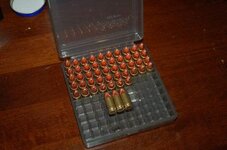- Messages
- 105
- Reactions
- 11
This is my first time reloading. I finally got to making a set of 10 9MM dummy rounds. All 10 rounds chamber and eject great. I was aiming for 1.130 OAL and
.376 on my crimp. These are the numbers I come up with. so how did I do? The number I picked was based on the average of factory ammo, such as Remington, Federal, Winchester. These are using Berry's plated 115 GR and I will be staring with a low load of 4.3 and working my way up to 4.7 Gr of Winchester 231 powder. I plan on making 6-8rounds of each grain as I step up.
1.125 .374
1.129 .375
1.131 .376
1.130 .374
1.133 .373
1.133 .376
1.136 .377
1.133 .376
1.127 .373
1.134 .377
.376 on my crimp. These are the numbers I come up with. so how did I do? The number I picked was based on the average of factory ammo, such as Remington, Federal, Winchester. These are using Berry's plated 115 GR and I will be staring with a low load of 4.3 and working my way up to 4.7 Gr of Winchester 231 powder. I plan on making 6-8rounds of each grain as I step up.
1.125 .374
1.129 .375
1.131 .376
1.130 .374
1.133 .373
1.133 .376
1.136 .377
1.133 .376
1.127 .373
1.134 .377















